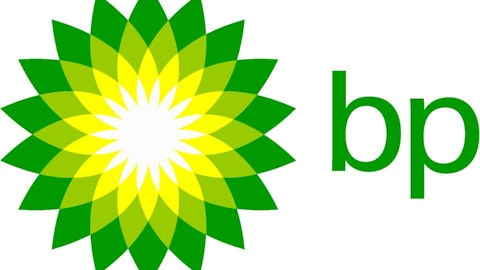The European oil major, BP plc (ADR) (NYSE:BP) released its quarterly results that were a disappointment. The company’s income dropped significantly due to falling oil prices, a higher tax rate and lower income from Russia. Its stock has under performed while it continues to face legal challenges from the oil spill disaster. But BP plc (ADR) (NYSE:BP) pays out healthy dividends, has high quality assets and I believe it can be a good investment for those looking for long term growth.
Quarterly Results
BP plc (ADR) (NYSE:BP)’s adjusted net income dropped from $3.6 billion in last years second quarter to $2.7 billion this past quarter, which is significantly below the market’s expectations of $3.4 billion. This was attributed to lower oil prices, an unusually large underlying effective tax rate of 45%, as opposed to 35% the year before, and a drop in profits from Russia due to the Russian oil export duties and weakness in the Ruble.
Dividend and Buybacks
Although shares of European oil majors, such as BP plc (ADR) (NYSE:BP) and Royal Dutch Shell plc (ADR) (NYSE:RDS.A) have under performed as compared to the broader market and their American peers, they continue to reward shareholders through dividends and share buybacks. BP plc (ADR) (NYSE:BP) offers an attractive 5.2% yield while Royal Dutch Shell plc (ADR) (NYSE:RDS-A) gives more than 4%. BP plc (ADR) (NYSE:BP) is an attractive income play and continues to emphasize its commitment to its dividend and share buyback policy.
Traditionally, Royal Dutch Shell plc (ADR) (NYSE:RDS-A) has preferred the route of dividends to reward shareholders but lately, it has been increasing its pace of buybacks. In the last twelve months, Royal Dutch Shell plc (ADR) (NYSE:RDS-A) paid out more than $11 billion in dividends. So far in 2013, $3.2 billion in shares have been repurchased and the company is on pace to for a total of $4 to $5 billion in buybacks this year.
Strong Asset Portfolio
BP plc (ADR) (NYSE:BP)’s $38 billion divestment target has been achieved which will make the company more focused on its core assets. BP has an impressive asset portfolio and has operations spread across the globe. The business has been actively pursuing deep-water opportunities, which is evident in its operations at the Gulf of Mexico, Brazil and India.
At the Gulf of Mexico, BP has spudded the Gila well and will start operating an additional rig in the region by the end of the year . Here, BP has its crown jewel, the largest offshore platform in the world called Thunder Horse. By the end of 2013, BP will be operating a total of 8 rigs in the Gulf of Mexico .
Although BP’s future in North America looks challenging — after the U.S Environmental Protection Agency’s decision to suspend the energy giant’s ability to win new federal government contracts — but it has been making significant progress in the emerging markets .

Source: BP Company Presentation
BP also has a 19.75% stake in the Russian energy behemoth Rosneft. The growth of Rosneft will help boost BP’s production, last quarter collection 945 thousand barrels of oil equivalent per day, and would open a new income stream through dividends from Rosneft.
BP has made a major gas discovery in India’s KG-D6 deepwater block, the details of which will be released once the exploration and research work is complete and this follows the progress in Brazil where the company has been awarded eight new deepwater blocks in the last licensing round .
Also BP has started two big upstream projects in 2013; the Atlantis North Expansion and the Angola LNG projects. Besides these, four other major upstream projects will also start later this year . The company is currently working on 11 wells and will complete the exploration work on 15 to 20 wells by the end of the year .
Conclusion
In terms of valuation, BP looks attractive. It is currently trading at 1.4 times tangible book value and has positioning itself for long term growth, something other large integrated majors have not. Management’s effectiveness is evident in its ability to generate a healthy return on equity of 21.4%, which is considerably higher than the industry’s average of 13% .
The article What Makes This European Oil Major A Buy? originally appeared on Fool.com and is written by Sarfaraz Khan.
Sarfaraz Khan has no position in any stocks mentioned. The Motley Fool has no position in any of the stocks mentioned.
Copyright © 1995 – 2013 The Motley Fool, LLC. All rights reserved. The Motley Fool has a disclosure policy.



